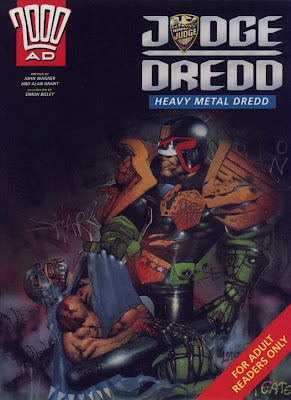(Reprints Heavy Metal
Dredd stories from Judge Dredd
Megazine #1.14, 1.16-1.19, 2.13, 2.19, 2.21-2.25, 2.34-2.36, 2.61-2.62,
3.15, 3.17, 3.33)
The short-lived pan-European heavy metal magazine Rock Power launched in June, 1991; the
first issue's cover featured Skid Row, and also billed interior appearances by
the likes of LA Guns, Faith No More, Metallica and... Judge Dredd. For some
reason, they commissioned a series of six-page Dredd stories by John Wagner,
Alan Grant and Simon Bisley (at least at first), which mostly had something to
do with hard rock in one way or another, and were subsequently reprinted in
random issues of Judge Dredd Megazine whenever it needed some extra
content. Then, as I understand, there were more similar stories commissioned
for the Meg when the Rock Power ones ran out; they were
followed, then and in this collection, by early pieces that had initially
seemed not quite tasteful enough for Dredd's own title, or something.
(Speaking of the Megazine:
with this week's installment, we officially move into the period where David
Bishop was editing it. It's a fairly well-documented period, thanks to the
warts-and-all history that appeared in the Meg
itself, written by one David Bishop, who curiously refers to himself in the
third person throughout. As he does in Thrill-Power
Overload, for that matter. What I gather is that the creative budget for
the Megazine was trimmed around the time
he came on--it was rather extravagant for its time and place, hence the fancy
painted artwork in a lot of its strips--and Bishop started reprinting the Heavy Metal Dredd stuff as a cost-saving
measure.)
(There are also a handful of unreprinted-in-book-form
Dredd-universe strips from the final issues of the Megazine Vol. 1. John Wagner and Steve Sampson's "Brit-Cit
Babes" has one great selling point--a Brian Bolland cover on the first
issue in which it appeared--but it's distinctly lesser Wagner, and in fact he
apparently gave up on it midway through its final episode, leaving it to Bishop
to finish off. The Dave Stone-written, Brit-Cit-set "Armitage" has
continued to appear intermittently right up to the present. And Bishop and the
wonderful Roger Langridge collaborated on a comedy strip I've never seen, called
"The Straitjacket Fits"; given that they're both from New Zealand,
that has to be a reference to the Dunedin band of the same
name.)
But right: Heavy Metal
Dredd. That's heavy metal as in rock, but also Heavy Metal as in
Fluide Glacial-but-crasser:
visual spectacle trumps plot at every turn, what plot there is tends to be
pretty dumb, and the way-over-the-top hyperviolence seems to be more about
assuring their readers that this isn't namby-pamby kid stuff than anything else.
(It was apparently debated at length in the Megazine
letters section.) Eight of these stories are by the Wagner/Grant/Bisley team,
and none of them are as thrilling as any six-page cross-section of Judgment on Gotham. The polite John
Major-as-Batman type who gets his head bitten off in "Chicken Run" is
a nice touch, though.
Curiously, the Bisley episodes that work best are the ones
where he doesn't try to do a hastier version of his Judgment full-painting style: "The Great Arsoli" has a
spluttering Ralph Steadman-ish approach that's rarely been attempted in action
comics, and "Bimba" strips Bisley's technique down to very little
more than gestural doodles. (A lot of its its final page appears to have been
produced by Bisley deciding "fuck it" and seeing what he could do with
two Magic Markers in forty seconds. Don't try that at home.)
Commissioning editor Steve McManus asserted that HMD was out of continuity, "a
separate and aggressive Dredd world"; not much implies otherwise, and even
the version of Judge Karyn that appears in "Graceland" doesn't look
much like the familiar one. That might have something to do with the other
featured artist here, the late John Hicklenton, whose eight episodes might be the
closest Dredd has ever come to
"outsider art" (put that in as many sets of quotation marks as you
like). They're more Throbbing Gristle than L.A. Guns, really. Hicklenton, per
his interview in the Megazine in
2003, drew one episode while on acid in his tent at the Glastonbury music
festival; it says something that I can't tell which one.
Grant and Wagner weren't a particularly apt match for
Hicklenton--their scripts for him follow the "when all else fails, stupid
= funny" formula. Hicklenton was much more focused on grotesquerie than on stupidity, so John
Smith's scripts for a handful of these episodes were right up his alley. (I
believe these were the first published Dredd stories proper by Smith, a very
interesting if frequently frustrating writer whose early Devlin Waugh stories Graeme McMillan and I will be discussing at
some length here in a couple of weeks.) I mean, Dredd unzipping and emerging from a female-bodied fat suit? I can't think
of any earlier artist on the series who'd even have attempted to get away with that. Hicklenton didn't truck much with subtlety, though, as you can see below.
As for the three other artists who drew an episode apiece
during the Grant/Wagner period here: I do like Brendan McCarthy's work
on "The Ballad of Toad McFarlane," which gives him the opportunity to
draw psychedelic effects again, and even letterer Tom Frame gets to have a little fun in that episode,
returning to the eagle-shaped caption borders of "Oz." But how many Rock Power readers in 1992 would have
gotten the joke of the title?
Here's a question that's less rhetorical: I gather that Bisley's
very first Heavy Metal Dredd strip
was reprinted in a poster magazine included with 2000 AD #1068, but with entirely rewritten captions and dialogue.
Anybody able to confirm or deny that, and/or (if it's the case) explain how it happened?
































